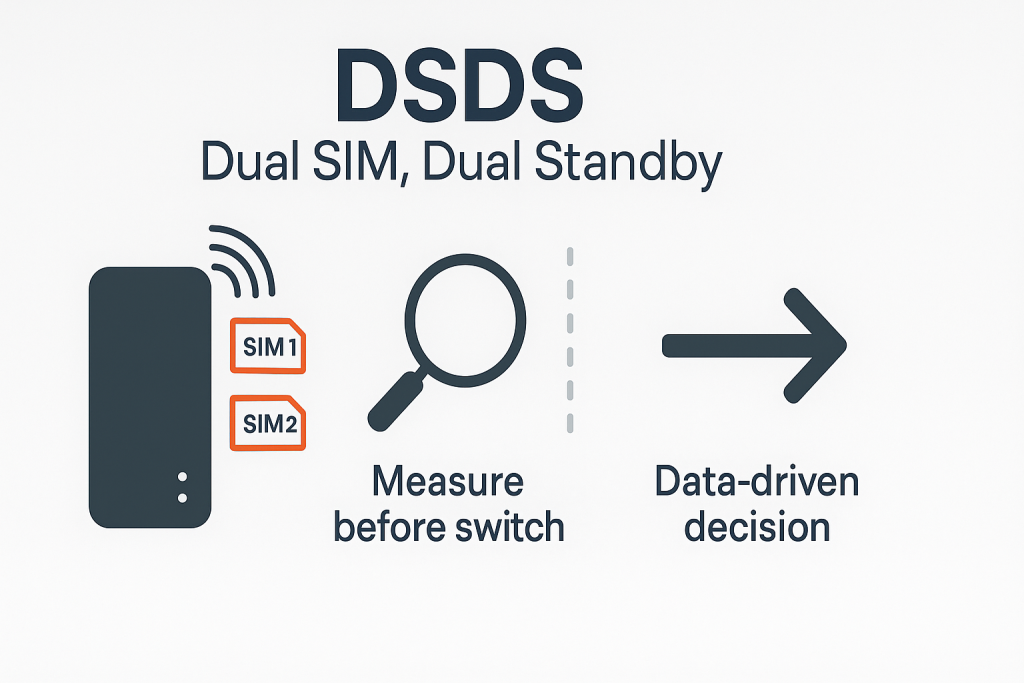
Table of Contents
Businesses have leaned on multi-carrier strategies for years to keep sites online: one device, two SIMs; or two devices/two modems. Until now, though, “two SIMs in one modem” has mostly meant a blind, disruptive failover: the router drops the current SIM and hopes the other carrier is better. If it isn’t, you just traded one problem for another—and lost time doing it.
Dual SIM, Dual Standby (DSDS) changes that. Instead of guessing, DSDS continuously gathers evidence about the alternate SIM’s actual network quality—signal, latency, throughput—and only switches when the data says it should. The result: fewer needless cutovers, faster recovery, and smarter use of your cellular resources.
A quick primer: DSDS on phones vs. routers
If you’ve used recent iPhones, you’ve experienced a flavor of this: two active profiles (often eSIMs), one radio stack that can evaluate and pivot quickly to keep your experience smooth. DSDS in a router brings a similar idea to fixed wireless access (FWA): the router uses a single modem and antenna system to observe and measure both carriers opportunistically, then makes a data-driven decision to switch—not a leap of faith.
How things used to work: one modem, two SIMs (legacy)
Traditional dual-SIM behavior in many routers looks like this:
- The primary SIM degrades (RSSI/RSRP drops, latency spikes, throughput craters).
- The router triggers a failover without knowing whether the secondary SIM is actually better.
- It tears down registration on carrier A, re-registers on carrier B, establishes data bearers, reauthenticates, and rebuilds sessions.
- If carrier B is worse (or has a local outage), you’re stuck doing the dance again—burning minutes and creating user pain.
How long does the switch take?
It varies by network and configuration, but it’s often measured in tens of seconds due to deregistration/registration, APN attach, authentication, and IP session setup. That’s long enough to drop calls, interrupt POS terminals, freeze video streams, and trigger app timeouts in kiosks or branches.
The problems with “blind” switching
- You don’t know if the next carrier is healthier until after you cut over.
- You can bounce between carriers during transient issues.
- You waste data and operational time testing by trial-and-error.
- You can misdiagnose LAN/app issues as WAN problems, because the failover process itself adds disruption.
Two-modem solutions: powerful, but not always practical
Running two modems (in one chassis or two devices) gives you true parallelism—you can fully monitor and measure both carriers at once and even bond/steer traffic. That’s fantastic for mission-critical sites, but it comes with trade-offs:
- Cost & complexity: more radios, more antennas, more licensing/power, more configuration.
- Space & RF planning: antenna placement and isolation matter; enclosures get bigger.
- Operational overhead: more inventory variants, spares, and fleet management surface area.
For many small/medium sites, pop-ups, kiosks, retail lanes, and single-WAN branches, a smarter one-modem approachthat thinks before it switches is the sweet spot.
Why DSDS is revolutionary for 5G routers
DSDS brings the decision quality of two-modem logic to a single-modem architecture:
- Measure before you move: The router tests the secondary SIM’s conditions first—signal, latency, and even real throughput using on-device speed tests—so failover is evidence-driven rather than hopeful.
- Faster, cleaner failovers: Because the router knows the target network is viable, you avoid ping-pong and needless downtime.
- Lower TCO vs. dual-modem: One modem, one antenna set, simpler installs, smaller envelopes, less hardware to manage.
- Smarter startup: With automatic carrier selection, the device can choose the strongest signal or the fastest speed at boot—whichever best fits your policy.
The FX4200: DSDS-style intelligence plus practical tools
What makes the Inseego Wavemaker FX4200 such a strong DSDS showcase is that it couples intelligent SIM decisions with practical, field-ready features that remove friction across the lifecycle:
1) Built-in site survey mode (with battery)
The FX4200 includes a rechargeable backup battery and a front display/LEDs so a technician can walk the site and see signal strength live—no laptop or external tester needed. Find the best spot first, install once, and move on.
- Battery management: During extended outages, you can disable non-critical features to extend runtime.
2) Dual SIMs + automatic carrier selection
Load two carrier SIMs. On startup the FX4200 can pick strongest signal or fastest speed depending on your policy—using the device’s on-board speed test to verify real performance.
3) Cloud automation & APIs
With Inseego Connect, you can schedule periodic speed tests, monitor fleet-wide signal/health, push configs/firmware, and pull telemetry via APIs into your own dashboards—so decisions (and alerts) are proactive, not reactive.
DSDS vs. legacy dual-SIM vs. dual-modem: when to use what
| Scenario | Legacy 1-Modem/2-SIM (Blind) | 1-Modem/2-SIM with DSDS | 2-Modem |
|---|---|---|---|
| Branch/retail lane needing high uptime w/ low complexity | ⚠️ Risk of bad failovers | ✅ Best fit | Possible overkill |
| Pop-ups, kiosks, temporary sites | ⚠️ Disruption during swaps | ✅ Best fit | Rarely needed |
| Mobile units (service, public safety adjunct WAN) | ⚠️ Network bounce pain | ✅ Great balance | Sometimes (for bonding) |
| Mission-critical (live video, command centers, SD-WAN bonding) | ❌ | ✅ (good) | ✅ Best(bond/steer) |
What about “instant” switching?
Even with DSDS, physics and networks still matter—registration and bearer setup take some time. The big win is that DSDS avoids “bad switches” and pre-validates the alternate path, cutting the number of transitions and reducing the total downtime you’d otherwise incur chasing ghosts.
Learn more / next steps
Have questions about designing with DSDS, deciding between single- and dual-modem architectures, or carrier mix? 5Gstore’s engineering team can help you right-size the solution for your uptime, budget, and operational goals.

